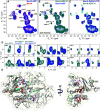Solid-State NMR Reveals Asymmetric ATP Hydrolysis in the Multidrug ABC Transporter BmrA
- PMID: 35776907
- PMCID: PMC9284561
- DOI: 10.1021/jacs.2c04287
Solid-State NMR Reveals Asymmetric ATP Hydrolysis in the Multidrug ABC Transporter BmrA
Abstract
The detailed mechanism of ATP hydrolysis in ATP-binding cassette (ABC) transporters is still not fully understood. Here, we employed 31P solid-state NMR to probe the conformational changes and dynamics during the catalytic cycle by locking the multidrug ABC transporter BmrA in prehydrolytic, transition, and posthydrolytic states, using a combination of mutants and ATP analogues. The 31P spectra reveal that ATP binds strongly in the prehydrolytic state to both ATP-binding sites as inferred from the analysis of the nonhydrolytic E504A mutant. In the transition state of wild-type BmrA, the symmetry of the dimer is broken and only a single site is tightly bound to ADP:Mg2+:vanadate, while the second site is more 'open' allowing exchange with the nucleotides in the solvent. In the posthydrolytic state, weak binding, as characterized by chemical exchange with free ADP and by asymmetric 31P-31P two-dimensional (2D) correlation spectra, is observed for both sites. Revisiting the 13C spectra in light of these findings confirms the conformational nonequivalence of the two nucleotide-binding sites in the transition state. Our results show that following ATP binding, the symmetry of the ATP-binding sites of BmrA is lost in the ATP-hydrolysis step, but is then recovered in the posthydrolytic ADP-bound state.
Conflict of interest statement
The authors declare no competing financial interest.
Figures








Similar articles
-
The C-terminal α-helix is crucial for the activity of the bacterial ABC transporter BmrA.J Biol Chem. 2025 Feb;301(2):108098. doi: 10.1016/j.jbc.2024.108098. Epub 2024 Dec 18. J Biol Chem. 2025. PMID: 39706270 Free PMC article.
-
ATP Analogues for Structural Investigations: Case Studies of a DnaB Helicase and an ABC Transporter.Molecules. 2020 Nov 12;25(22):5268. doi: 10.3390/molecules25225268. Molecules. 2020. PMID: 33198135 Free PMC article. Review.
-
Rhodamine6G and Hœchst33342 narrow BmrA conformational spectrum for a more efficient use of ATP.Nat Commun. 2025 Feb 18;16(1):1745. doi: 10.1038/s41467-025-56849-z. Nat Commun. 2025. PMID: 39966360 Free PMC article.
-
The conserved glutamate residue adjacent to the Walker-B motif is the catalytic base for ATP hydrolysis in the ATP-binding cassette transporter BmrA.J Biol Chem. 2003 Nov 21;278(47):47002-8. doi: 10.1074/jbc.M308268200. Epub 2003 Sep 10. J Biol Chem. 2003. PMID: 12968023
-
The mechanism of action of multidrug-resistance-linked P-glycoprotein.J Bioenerg Biomembr. 2001 Dec;33(6):481-91. doi: 10.1023/a:1012875105006. J Bioenerg Biomembr. 2001. PMID: 11804190 Review.
Cited by
-
Solid-state NMR chemical shift analysis for determining the conformation of ATP bound to Na,K-ATPase in its native membrane.RSC Adv. 2023 Nov 29;13(49):34836-34846. doi: 10.1039/d3ra06236h. eCollection 2023 Nov 22. RSC Adv. 2023. PMID: 38035247 Free PMC article.
-
Fluoride permeation mechanism of the Fluc channel in liposomes revealed by solid-state NMR.Sci Adv. 2023 Aug 25;9(34):eadg9709. doi: 10.1126/sciadv.adg9709. Epub 2023 Aug 23. Sci Adv. 2023. PMID: 37611110 Free PMC article.
-
The C-terminal α-helix is crucial for the activity of the bacterial ABC transporter BmrA.J Biol Chem. 2025 Feb;301(2):108098. doi: 10.1016/j.jbc.2024.108098. Epub 2024 Dec 18. J Biol Chem. 2025. PMID: 39706270 Free PMC article.
-
Asymmetry in three-site relaxation exchange NMR.Magn Reson (Gott). 2023 Aug 24;4(2):217-229. doi: 10.5194/mr-4-217-2023. eCollection 2023. Magn Reson (Gott). 2023. PMID: 37904857 Free PMC article.
-
The Switch and Reciprocating Models for the Function of ABC Multidrug Exporters: Perspectives on Recent Research.Int J Mol Sci. 2023 Jan 30;24(3):2624. doi: 10.3390/ijms24032624. Int J Mol Sci. 2023. PMID: 36768947 Free PMC article. Review.
References
-
- Dean M.; Rzhetsky A.; Allikmets R. The human ATP-binding cassette (ABC) transporter superfamily. Genome Res. 2001, 11, 1156–1166. 10.1101/gr.184901. - DOI - PubMed
- Schneider E.; Hunke S. ATP-binding-cassette (ABC) transport systems: functional and structural aspects of the ATP-hydrolyzing subunits/domains. FEMS Microbiol. Rev. 1998, 22, 1–20. 10.1111/j.1574-6976.1998.tb00358.x. - DOI - PubMed
-
- Kerr I. D. Structure and association of ATP-binding cassette transporter nucleotide-binding domains. Biochim. Biophys. Acta, Biomembr. 2002, 1561, 47–64. 10.1016/S0304-4157(01)00008-9. - DOI - PubMed
- Wilkens S. Structure and mechanism of ABC transporters. F1000Prime Rep. 2015, 7, 14.10.12703/p7-14. - DOI - PMC - PubMed
- Rees D. C.; Johnson E.; Lewinson O. ABC transporters: the power to change. Nat Rev Mol Cell Biol 2009, 10, 218–227. 10.1038/nrm2646. - DOI - PMC - PubMed
Publication types
MeSH terms
Substances
LinkOut - more resources
Full Text Sources

